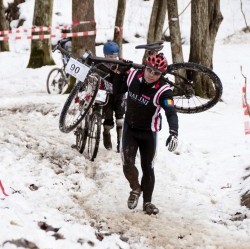-
Planning your winter training
- Posted onliz
- in Website Articles
- onJanuary 5, 2018
- No Comments.
 Even though the weather is pretty awful right now with dark nights, cold temperatures and all the obstacles to getting out on your bike, you can still make training gains and smart decisions so that when the better weather does come you can hit the ground running! Here are 5 key components of your winter training plan:
Even though the weather is pretty awful right now with dark nights, cold temperatures and all the obstacles to getting out on your bike, you can still make training gains and smart decisions so that when the better weather does come you can hit the ground running! Here are 5 key components of your winter training plan:1. Develop your skills. Think about your skill level in each discipline and plan to improve it. At this time of year your swim sessions should be all about drills – a simple one is to count the number of strokes per length and then try to reduce this. On the bike, some off-road mountain biking could improve bike handling, or some turbo work (one-legged pedaling anyone?) could improve pedaling efficiency. A simple step like learning to skip (with a rope) can promote big run improvements.
2. Aerobic conditioning. Over the winter, you should either start or continue to enhance your aerobic condition. This is the cornerstone of your training through the year. Training aerobically develops your heart, your lungs, and increases the number and activity of mitochondria (energy producing cell components) all leading to a better performance on race day. Simply put, for the majority of new athletes, your aerobic sessions should be low-intensity – you should be able to maintain a conversation….
3. Develop your strength. This is the perfect time of year to be developing strength that you can carry over into your spring training. Muscle strength and core conditioning play an important part in training for a long distance event particularly once you are over 30! This sort of training does not have to be weight training in a gym (although this is excellent) but can include body weight exercises, resistance bands, swiss balls and medicine balls to name just a few options. You should, at all times, focus on the quality of the exercise rather than speed or number of repeats and include work to develop core strength, work on specific weaknesses and for most athletes, focus on single-leg leg strength. (Note – if you are interested in working on your core take a look at the 12 week Transform your Triathlon Core Program).
4. Set clear goals. For each of the components above you should set clear goals. Don’t let the winter pass by without developing as an athlete. Progress can be monitored with simple measures such as a) the number of press ups that you can do b) the length of time that you can pedal with one leg only c) the minimum number of strokes you can take in your pool (reduction in this value indicating an improvement in streamlining and body balance and to some extent your kick).
5. Transform your weakness. The winter months are a great time of year to focus on your weaknesses. If you are new to the sport – what are you most concerned about? If a regular competitor – what let you down last year? Whatever your weakness you now have this wonderful opportunity to change it. If your weakness is skill based then get some lessons, or join a coached session but the key is also to do MORE of the discipline that is holding you back – you can transform your swim, bike or run in 8-10 weeks. For example, if you are a ‘6 sessions per week’ athlete with a swim weakness then your winter training could include 3 swim sessions, 1 bike session, 1 run session and 1 strength session per week. Or, if you are a 9 sessions a week athlete who loses places on the run, then your week could include 4 runs per week, 2 bikes, 1 swim and 2 strength sessions. Click here for more information on our Transformer series of programs.
If you enjoyed this article please consider sharing it!




